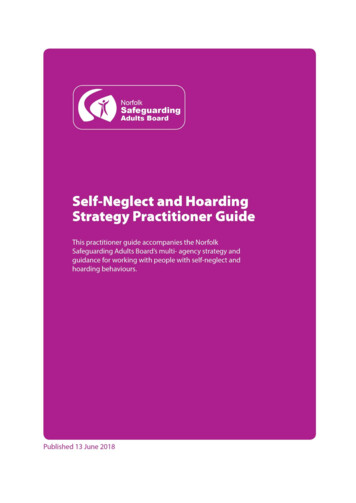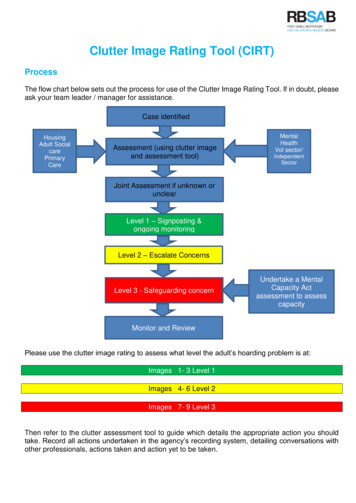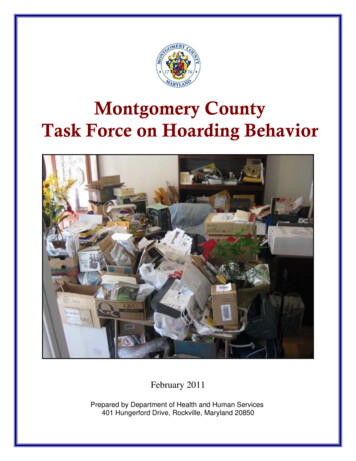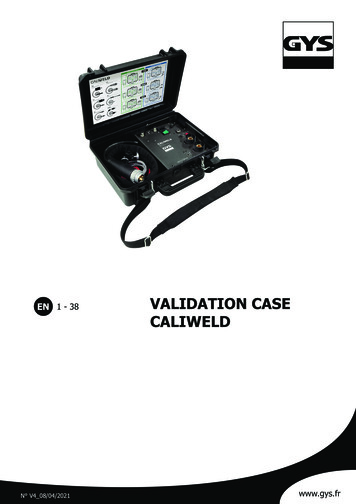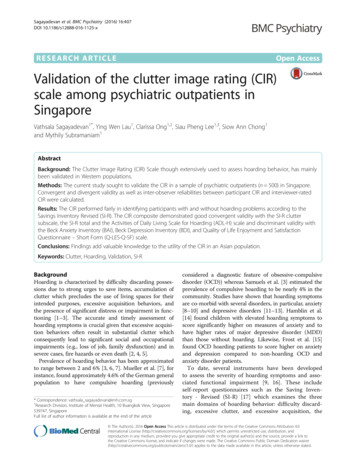
Transcription
Sagayadevan et al. BMC Psychiatry (2016) 16:407DOI 10.1186/s12888-016-1125-xRESEARCH ARTICLEOpen AccessValidation of the clutter image rating (CIR)scale among psychiatric outpatients inSingaporeVathsala Sagayadevan1*, Ying Wen Lau1, Clarissa Ong1,2, Siau Pheng Lee1,3, Siow Ann Chong1and Mythily Subramaniam1AbstractBackground: The Clutter Image Rating (CIR) Scale though extensively used to assess hoarding behavior, has mainlybeen validated in Western populations.Methods: The current study sought to validate the CIR in a sample of psychiatric outpatients (n 500) in Singapore.Convergent and divergent validity as well as inter-observer reliabilities between participant CIR and interviewer-ratedCIR were calculated.Results: The CIR performed fairly in identifying participants with and without hoarding problems according to theSavings Inventory Revised (SI-R). The CIR composite demonstrated good convergent validity with the SI-R cluttersubscale, the SI-R total and the Activities of Daily Living Scale for Hoarding (ADL-H) scale and discriminant validity withthe Beck Anxiety Inventory (BAI), Beck Depression Inventory (BDI), and Quality of Life Enjoyment and SatisfactionQuestionnaire – Short Form (Q-LES-Q-SF) scale.Conclusions: Findings add valuable knowledge to the utility of the CIR in an Asian population.Keywords: Clutter, Hoarding, Validation, SI-RBackgroundHoarding is characterized by difficulty discarding possessions due to strong urges to save items, accumulation ofclutter which precludes the use of living spaces for theirintended purposes, excessive acquisition behaviors, andthe presence of significant distress or impairment in functioning [1–3]. The accurate and timely assessment ofhoarding symptoms is crucial given that excessive acquisition behaviors often result in substantial clutter whichconsequently lead to significant social and occupationalimpairments (e.g., loss of job, family dysfunction) and insevere cases, fire hazards or even death [2, 4, 5].Prevalence of hoarding behavior has been approximatedto range between 2 and 6% [3, 6, 7]. Mueller et al. [7], forinstance, found approximately 4.6% of the German generalpopulation to have compulsive hoarding (previously* Correspondence: vathsala sagayadevan@imh.com.sg1Research Division, Institute of Mental Health, 10 Buangkok View, Singapore539747, SingaporeFull list of author information is available at the end of the articleconsidered a diagnostic feature of obsessive-compulsivedisorder (OCD)) whereas Samuels et al. [3] estimated theprevalence of compulsive hoarding to be nearly 4% in thecommunity. Studies have shown that hoarding symptomsare co-morbid with several disorders, in particular, anxiety[8–10] and depressive disorders [11–13]. Hamblin et al.[14] found children with elevated hoarding symptoms toscore significantly higher on measures of anxiety and tohave higher rates of major depressive disorder (MDD)than those without hoarding. Likewise, Frost et al. [15]found OCD hoarding patients to score higher on anxietyand depression compared to non-hoarding OCD andanxiety disorder patients.To date, several instruments have been developedto assess the severity of hoarding symptoms and associated functional impairment [9, 16]. These includeself-report questionnaires such as the Saving Inventory - Revised (SI-R) [17] which examines the threemain domains of hoarding behavior: difficulty discarding, excessive clutter, and excessive acquisition, the The Author(s). 2016 Open Access This article is distributed under the terms of the Creative Commons Attribution 4.0International License (http://creativecommons.org/licenses/by/4.0/), which permits unrestricted use, distribution, andreproduction in any medium, provided you give appropriate credit to the original author(s) and the source, provide a link tothe Creative Commons license, and indicate if changes were made. The Creative Commons Public Domain Dedication o/1.0/) applies to the data made available in this article, unless otherwise stated.
Sagayadevan et al. BMC Psychiatry (2016) 16:407Activities of Daily Living in Hoarding Scale (ADL-H)[18] which assesses the degree to which clutter interferes with one's daily activities, and the Clutter scale(CS) which enlists a series of questions to examinethe extent of clutter in each target room (i.e., kitchen,living room, bedroom) [9]. Others include semistructured interviews such as the Hoarding RatingScale-Interview (HRS-I) [19] which assesses the threemain features of hoarding (clutter, difficulty discarding, and excessive acquisition) as well as the distressand interference caused by the hoarding behavior.Despite the well-established psychometric properties ofthese hoarding measures, the main methodological issueposed by these instruments exists in the variability in theperception of what constitutes “clutter” which potentiallylimits the accuracy of self-reports of clutter [9]. To resolvethe problem associated with self-reports of the clutterdimension, Frost et al. [9] developed a visual analoguescale-Clutter Image Rating (CIR) Scale which aimed tomeasure the severity of clutter in compulsive hoarding.For instance, in the original validation study by Frost et al.[9], self-report measures assessing clutter (e.g., SI-R) werefound to differ significantly depending on the location inwhich they were completed, with those completed in theclinic having significantly higher scores than those completed at home. This difference however, was not observedfor the CIR, suggesting that it may be less likely to be affected by an over-reporting bias [9, 19]. The compositeCIR also showed a strong inter-observer reliability [9] witha reported participant/experimenter correlation of 0.78;according to Cohen [20], an absolute value of r of morethan 0.5 is classified as strong correlation.Although the CIR has been extensively used in studies toassess hoarding behavior, its utility has mainly been established in Western populations [9, 21]; to our knowledge,no such validation studies have been conducted in Asia.Possible cultural differences in hoarding symptoms havebeen found in studies which have validated the SI-R scale[22]. Yorulmaz and Dermihan [22] for instance, found themean score of total hoarding symptoms on the SI-R in aTurkish community sample to be lower than that of Western subjects. In comparing US and Chinese student samples, Timpano et al. [23] found the Chinese sample toendorse greater hoarding symptoms compared to the USsample on the SI-R. Furthermore, the Chinese sample wasfound to primarily endorse saving beliefs centered on usefulness and wastefulness in relation to hoarding as compared to their Western counterparts who endorsed a widerrange of beliefs. This difference was attributed to culturaldifferences in manifestation of hoarding tendencieswhereby the Chinese may feel more strongly about beliefson saving compared to their Western counterparts [23].Similarly, in validating the factor structure of the SIRin a psychiatric outpatient population in Singapore, LeePage 2 of 8et al. [24] found the SI-R scale, though consistent withFrost et al.’s [17] three factor structure: clutter, difficultydiscarding, and acquisition, to be empirically underidentified. The removal of two items on self-controlfrom the 23-item scale in turn, resulted in a marginalimprovement in model fit; a finding consistent withTimpano et al. [23]. One possible reason cited, was thepossibility of differential emphasis placed on the role ofself-control in collectivistic cultures [25], particularly inChinese culture whereby discarding of possessions maybe viewed as a wasteful habit rather than a maladaptivebehavior resulting from attachment to possessions [24].According to the cognitive behavioral model of hoarding [23, 26], three basic deficits: information processingproblems, beliefs related to emotional attachments topossessions, and the reinforcing impact of emotions andavoidance are posited to play a critical role in hoarding.In accordance with this, cultural differences in beliefsassociated with hoarding (i.e., wastefulness, usefulness)are likely to have an impact on hoarding behavior andthe level of clutter endorsed by individuals.Singapore is multicultural country in South-East Asiawith a population of 5.5 million; of its residents, 74.3% areof Chinese descent, 13.3% are Malay, 9.1% are of Indiandescent, and 3.3% belong to other ethnic groups [27].Given the cultural differences in hoarding tendencies andsymptoms observed in past validation studies of the SIR, itis unclear if the CIR, developed in a Western sample willbe valid in multicultural populations [23].Furthermore, the unique housing structure in Singaporewarrants validation of the scale in the local context giventhat the majority of the residents reside with family members in public housing developed by the Housing Development Board (HDB) [28]. These apartments are locatedwithin close proximity of one another whereby individualsoften have shared common areas; this is likely to have amoderating effect on the hoarding behavior and clutterlevel of individuals.In view of this, we sought to validate the CIR in a sample of psychiatric outpatients in Singapore to determineits utility in the local population. Specifically, we aimedto: (1) evaluate the accuracy of the CIR in identifyinghoarding status as classified by the SIR, and (2) establishthe convergent and divergent validity of the CIR withrelated and non-related constructs.MethodSampleThe Clutter Image Rating (CIR) scale was validated basedon the data collected from a study assessing hoardingbehaviour among psychiatric outpatients. Conveniencesampling was used to recruit five hundred outpatientsseeking treatment at the Institute of Mental Health(IMH), a tertiary hospital in Singapore specializing in
Sagayadevan et al. BMC Psychiatry (2016) 16:407psychiatric care between May 2014 and April 2015. Thestudy was approved by the institutional ethics committee(National Healthcare Group, Domain Specific ReviewBoard). To be eligible for the study, participants had to be:(1) at least 21 years old, (2) have a primary DSM-IV diagnosis of any anxiety disorder (AD; including OCD), anydepressive disorder (DD), schizophrenia (SZ), or pathological gambling (PG), (3) able to comprehend andcomplete the questionnaires in English, and (4) cognitivelycapable of providing informed consent. Participants withco-morbid conditions were also included in the presentstudy. Patients with cognitive deficits were excluded fromthe study [29]. The majority of the sample was male(56.4%) and of Chinese ethnicity (70.2%). Ten percent ofthe sample was of Malay ethnicity, 13.4% were Indian, and6.4% belonged to other ethnicities; the mean age of participants was 35.3 years (range 21–69).ProcedureAll participants signed an informed consent form prior tocompletion of the study questionnaire packet, which comprised a demographic questionnaire and the self-reportmeasures: Clutter Image Rating (CIR) Scale, Saving Inventory - Revised (SI-R), Saving Cognitions Inventory (SCI),Beck Anxiety Inventory (BAI), Beck Depression InventoryII (BDI-II), Activities of Daily Living Scale for Hoarding(ADL-H), and Quality of Life Enjoyment and SatisfactionQuestionnaire – Short Form (Q-LES-Q-SF). The administration of questionnaires was not part of their routine careand was performed solely for the purpose of research. Participants completed the questionnaires while waiting fortheir appointment or after their appointment. Upon completion of the study questionnaires, participants were reimbursed an inconvenience fee of 30 SGD. In addition, twotrained research assistants visited houses of participantswho were agreeable to a home visit (n 46; as indicated onthe consent form) at a convenient time within a few weeksof completing the questionnaire and separately rated therooms (i.e., kitchen, living room, bedroom) based on theCI-R. Research assistants were blinded to the diagnosis ofthe patients (i.e., they were not aware if the patients hadsignificant hoarding symptoms or not). Participants werecompensated with 10 SGD following the completion of thehome visit.Further details of the study can be found in previousarticles by Ong et al. [29] and Lee et al. [24].Page 3 of 8(least cluttered) to 9 (most cluttered). A mean compositescore ranging from 1 to 9 was calculated across the threerooms for each individual. Both composite and roomby-room scores were examined in this study. A cut-offscore of 4 or higher was used to indicate significant clutter requiring clinical attention [9]. Previous validationstudies on the CIR have demonstrated good psychometric properties [9]. Internal consistency for the currentsample was good (α .84).Saving inventory - revised (SI-R)The Saving Inventory-Revised (SI-R) [17] is a 23-item selfreport measure comprising three subscales: difficultydiscarding, clutter, and excessive acquisition. Items werescored between 0 (None) and 4 (Almost all/Complete),with higher scores indicating greater hoarding severity. Internal consistency, test-retest reliability, and convergent anddivergent validity have been established [10, 17]. A SI-Rcut-off score of 41 or higher indicates clinically significanthoarding symptoms [30]. This cut-off score was selected onthe basis that it maximized sensitivity ( 0.959) and specificity ( 0.931) for the scale (Unpublished data, cited in Tolinet al. [30]). Internal reliabilities for the full scale and threesubscales were good to excellent in the current sample(Cronbach’s α values ranged from .80 to .93).Saving cognitions inventoryThe Saving Cognitions Inventory (SCI) [26] is a 24-itemself-report measure that examines maladaptive beliefsabout and emotional attachment to possessions. It consists of four subscales: emotional attachment, control,responsibility, and memory. Participants are asked toindicate the extent to which they had each thought whendeciding whether or not to dispose something in thepast week. An example of an item is “I could not tolerateit if I were to get rid of this”. Scores ranged from 1 (notat all) to 7 (very much). The full scale and four subscalesshowed satisfactory internal consistency in the presentstudy (α values ranged from .78 to .96).Beck anxiety inventoryThe Beck Anxiety Inventory (BAI) [31] is a 21-item selfreport measure that evaluates distress associated withcommon symptoms of anxiety. Items are rated from 0(not bothered at all) to 3 (severely bothered). Internalconsistency for the current sample was excellent (α .95).InstrumentsClutter image rating (CIR) scaleBeck depression inventoryThe CIR consists of three pages of nine color photosrepresenting a range of clutter in the living room (LR),bedroom (BR) and kitchen (K). Patients were asked toselect the picture “that most accurately reflects theamount of clutter in your room”. Scores ranged from 1The Beck Depression Inventory-II (BDI-II) [32] is a 21-itemself-report measure that assesses depressive symptoms.Items are rated from 0 to 3, with higher scores indicatinggreater severity. Internal consistency for the current samplewas excellent (α .94).
Sagayadevan et al. BMC Psychiatry (2016) 16:407Activities of daily living scale for hoardingThe Activities of Daily Living Scale for Hoarding (ADL-H)[18] is a 15-item self-report measure that assesses thedegree of functional impairment in daily living activitiesdue to clutter. Responses are scored from 1 (can do iteasily) to 5 (unable to do), and are averaged across items,with higher scores indicating greater impairment. Internalconsistency for the current sample was excellent (α .96).Quality of life enjoyment and satisfaction questionnaire –short formThe Quality of Life Enjoyment and Satisfaction Questionnaire – Short Form (Q-LES-Q-SF) [33] is a 16-itemscale that assesses enjoyment and satisfaction acrossvarious life domains, including mood, social relationships, and economic status. Higher scores indicatehigher self-rated quality of life. Internal consistency forthe current sample was excellent (α .93).ResultsSample descriptionParticipants were classified into one of the diagnosticgroups on the basis of their primary diagnosis: depressivedisorders (DD; n 153; 30.6%), schizophrenia (SZ; n 150;30.0%), anxiety disorders (AD; n 144; 28.8%), and pathological gambling (PG; n 53; 10.6%). Within the AD group,9.8% had OCD (n 49), 7.6% had anxiety disorder nototherwise specified (NOS) (n 38), 5.0% had panic disorder (n 25), 4.0% had generalized anxiety disorder(GAD; n 20), 2.2% had social phobia (n 11), and 0.2%had specific phobia (n 1). In the DD group, 24.8% hadmajor depressive disorder (n 124), 3.4% had dysthymia(n 17), and 2.4% had depressive disorder NOS (n 12).Forty seven (9.4%) had a comorbid depressive disorder, 33participants (6.6%) had a comorbid anxiety disorder, and 9(1.8%) had comorbid anxiety and depressive disorders.Classification of hoarding statusAs the presence of clinically significant hoarding problemswas not a prerequisite for our study, the SI-R scores wereused as a reference to understand the hoarding characteristics in our sample. The SI-R has previously been validatedin a predominantly Chinese sample and was deemed as anappropriate comparison tool for the CIR [23, 24]. It waspreviously established that a cutoff score of 41 or higheron the SI-R would indicate clinically significant hoardingsymptoms [30]. Applying this to our sample, 147 participants (30.2%) were divided into the hoarding group andthe remaining 340 into the non-hoarding group. Thirteenparticipants were excluded as they did not fully completethe SI-R questionnaire, hence their SI-R scores were notcalculated and they were not classified into either of thetwo groups. Descriptive information for each of the studymeasures is provided in Table 1.Page 4 of 8Table 1 Descriptive information for study measuresaSI-R totalMeanSDMinimum- MeanMaximum inter-itemcorrelation30.815.970-770.37SCI 1.021-9Bedroom 1.671.011-9Kitchen0.931-9LivingRoom1.70n ranges from 434 to 487aA Receiving Operating Characteristic (ROC) curvewas constructed to evaluate the accuracy of theparticipant-rated CIR in identifying hoarding status asclassified by the SI-R. The accuracy is measured by theArea under the ROC curve (AUC); an area of 1 represents that the CIR is perfect and an area of 0.5 represents that the CIR is poor in terms of identification. Thereported AUC was 0.753, implying a relatively fair performance of the CIR in identifying participants with andwithout hoarding problems according to the SI-R. Compared to 30.2% of participants who were identified ashaving clinically significant hoarding symptoms on theSI-R, only 2.9% of participants were classified as havingsignificant hoarding symptoms based on the CIR. Theresults were similar for each of the three CIR rooms(living room 0.701, bedroom 0.713, kitchen 0.694).The inter-correlations among the three CIR roomswere high (Bedroom-Living Room r 0.66, BedroomKitchen r 0.61, Living Room-Kitchen r 0.65) and theCIR had good internal consistency (α 0.84).Convergent and discriminant validityThe CIR and ADL-H scores were non-normally distributed; hence, Spearman’s rho correlation coefficients wereused to determine the strength of associations amongthe variables.The CIR composite was significantly correlated with theSI-R clutter subscale (r 0.56), the SI-R total (r 0.54)and the ADL-H scale (r 0.51) (Table 2), which demonstrated convergent validity of the CIR on the clutter construct. In contrast, the correlations were weaker withmeasures of related constructs such as SCI (r 0.42) andother subscales of the SI-R (r from 0.27 to 0.47) (Table 2).The CIR composite score was also weakly correlated withnon-related constructs - BAI (r 0.253), BDI (r 0.229)
Sagayadevan et al. BMC Psychiatry (2016) 16:407Page 5 of 8Table 2 Correlations among CIR Composite, SI-R, ADL-H and SIRCIRCIR Living CIRCIRSI-Rcomposite RoomBedroom Kitchen totalSI-RclutterSI-R difficulty SI-RSCIdiscardingacquisition totalSCISCISCI emotional SCIcontrol responsibility attachmentmemoryCIR LivingRoom0.844CIR Bedroom0.8420.646CIR Kitchen0.8520.6160.589SI-R total0.5430.4850.4730.441SI-R clutter0.5640.5030.4690.4560.904SI-R difficultydiscarding0.4670.4000.4240.3880.888 0.713SI-Racquisition0.3900.3710.3340.3050.853 0.6260.698SCI total0.4170.3640.3840.3220.626 0.5200.6070.567SCI control0.2670.2130.2130.2270.418 170.2820.619 0.5190.5850.5780.926 0.697SCI emotionalattachment0.3980.3420.3660.3080.610 0.5070.5950.5540.949 0.6840.824SCI memory0.4120.3510.3560.3240.601 0.5210.5710.5300.896 0.6150.8150.812ADL-H0.5130.4400.4410.4320.566 0.5820.4880.4140.379 0.2850.3440.3830.374All correlations had p-values 0.001and Q-LES-Q-SF (r -0.239) (Table 3). In this regard, theCIR also demonstrated good discriminant validity.Inter-rater reliabilitiesTo establish reliability of the CIR, inter-observer reliabilities were calculated for participant CIR and interviewerrated CIR on the subset of 46 participants.Cohen’s k was run to first determine consistency between the two interviewers on their rating of hoarding status using the CIR. There was fair to moderate agreementbetween the two interviewers for each of the three rooms(Kitchen: k 0.482; p-value 0.001; 95% CI [0.272, 0.691]),(Bedroom: k 0.372; p-value 0.001; 95% CI [0.162,0.582]), (Living room: k 0.507; p-value 0.001; 95% CITable 3 Correlations of CIR Composite with BAI, BDI and Q-LESQ-SFCIRCIR livingcomposite roomCIR 0.616CIRCIRbedroom 27-0.184-0.588 -0.667All correlations had p-values 0.001[0.309, 0.705]), as well as the composite CIR (k 0.382; pvalue 0.001; 95% CI [0.225, 0.539]). Consistencies between non-corresponding rooms were significant with alower level of agreement.Inter-rater reliability between interviewers andparticipants were calculated using Spearman’s rhocorrelation coefficient to understand how closely theparticipants’ CIR ratings in the clinic matched the interviewers' CIR ratings in the house. The average ofthe interviewers’ ratings was used for the calculation.It was noted that the ratings were left skewed, hence, thecoefficients were corrected for restriction of range usingThordike Case II [34] to obtain a more accurate relationship. The corresponding rooms and composite scores correlated significantly except for the correlation betweenparticipant CIR-Bedroom and interviewer CIR Kitchen (r .351, p .05) and the correlation between participantCIR-Bedroom and interviewer CIR-living room (r .193,p .05) (Table 4).DiscussionThe current study sought to validate the ClutterImage Rating (CIR) Scale among psychiatric outpatients in Singapore. In seeking to establish the accuracy of the CIR in identifying hoarding status (i.e.,individuals with/without clinically significant hoardingsymptoms) as classified by the SI-R, the CIR revealeda relatively fair performance. Compared to 30.2% ofparticipants who were identified as having clinicallysignificant hoarding symptoms on the SI-R, only 2.9%
Sagayadevan et al. BMC Psychiatry (2016) 16:407Page 6 of 8Table 4 Correlations of CIR ratings by participants with CIR byinterviewersInterviewer CIRParticipant CIRKitchenBedroomLiving m0.3510.445a0.1930.441aLiving 50.4640.367Correlation is significant at the 0.05 level (2-tailed) n 44Correlation is significant at the 0.01 level (2-tailed)abof participants were classified as having significanthoarding symptoms based on the CIR. The SI-R meanscore in the current study closely mirrored those reportedby Timpano et al. [23] in their Chinese sample, wherebymore hoarding symptoms were endorsed by the Chinesesample on the SI-R compared to their western counterparts. It is possible that potential cultural differences (e.g.,greater importance accorded to saving beliefs) could haveresulted in the endorsement of more hoarding symptomson the SI-R which may have inflated the score on thisscale.Likewise, the discrepancy in identification could bedue to the two scales measuring different aspects ofhoarding; CIR being a measure of the consequence ofhoarding (i.e., Clutter) and the SI-R being a measure ofhoarding behaviors.The instrument showed good internal consistency withhigh correlations among the three CIR rooms (kitchen,living room, bedroom). The scale also demonstratedgood convergent validity with related measures of cluttersuch as the SI-R clutter subscale and the ADL-H scale.The CIR composite score was significantly correlatedwith all three subscales of the SI-R, particularly the clutter subscale. This was in line with Frost et al. [9] whofound participants' CIR scores in the clinic and at hometo be more strongly correlated with their ratings of theSI-R clutter subscale than with the other SI-R subscales.Likewise, the current results were also supported byDozier and Ayers's [21] study among adults aged 40–87years old. The CIR score was significantly correlatedwith the SI-R total and the SI-R Clutter subscale in boththe late life sample (adults aged 60–87 years) and in themid-life sample (adults aged 40–59 years) [21]. Furthermore, the CIR score was not found to be significantlyrelated to the ‘difficulty discarding’ and ‘acquisition’ subscales of the SI-R in both their samples [21]. Dozier andAyers [21] also noted significant associations betweenthe CIR and the ADL-H in both their late-life and themid-life sample, a finding that paralleled our result.This association between ADL impairment andhoarding was reflected in Ayers et al.'s [35] studywhereby hoarding severity measures (including CIR)in a late life sample was found to be positively associated with ADL impairment. Hoarding participantswere found to report “moderate to great difficulty” in finding important things, moving around inside the house,eating at the table, using the kitchen sink, preparing food,and sleeping in bed whereas control participants indicatedmoderate to great difficulty only in terms of ‘finding important items’ [35].Conversely, the CIR also indicated good discriminantvalidity through weaker correlations with non-clutter related subscales and scales such as the BAI, BDI, Q-LESQ-SF, SCI and the SI-R subscales of ‘difficulty discarding’ and ‘acquisition’. Past literature with regard to theassociation between hoarding and affect has generallyyielded inconsistent findings [9]. As with the currentstudy, Frost et al. [9] study, found the CIR compositescore to be significantly but moderately correlated withthe BAI scores. Likewise, Coles et al. [10] found a strongassociation between hoarding and anxiety sensitivity in anon-clinical sample of undergraduate psychologystudents whereby heightened levels of anxiety sensitivitywas found to contribute to avoidance of discarding. Incontrast to our study however, Frost et al. [9] did notfind any significant associations between the CIR andBDI scores. Interestingly, our results were partially reflective of Frost et al's [9] findings in that althoughsignificant, the correlations between CIR scores andBAI were generally higher than that between CIRscores and BDI.These findings are in line with Frost and Hartl’s [1]cognitive-behavioral model of compulsive hoardingwhereby individuals may avoid discarding objects so as notto experience an unpleasant emotional state which maynegatively reinforce maladaptive hoarding behaviors. Thishas implications in terms of treatment whereby focus canbe placed on coping with negative emotional symptoms(i.e., anxiety and depressive symptoms) to better managehoarding behaviors.Inter-observer reliabilities between participant CIRand interviewer-rated CIR revealed significant correlations for corresponding rooms and composite scores.This was generally lower than figures reported by studiessuch as Frost et al. [9] which found the correlation between the CIR completed by the participant and thetherapist to be high (r .78) whereas, in Dozier andAyer's [21] late life sample, the association between theparticipant and clinician was moderate (r .54). While itis possible that the participant-rated CIR in the clinic isa good representation of their homes, the low correlation might be partly attributed to the time lag betweenthe completion of the CIR in the clinic and the homevisit which would have allowed ample time for participants to clean up their clutter. Also, a large majority ofthe participants in our sample were living in HDB flats
Sagayadevan et al. BMC Psychiatry (2016) 16:407(87.7% of the patients) with 69% staying with their immediate family. It is possible that clutter could be regularly monitored and disposed of by family memberswhich prevented the buildup of clutter which could inturn have resulted in the discrepancy and low correlations between participant and interviewer ratings.The current findings however, should be considered inview of the study limitations. There is a potential selectionbias given that home visits were conducted only for a subsample of participants; it is thus possible that those whodid not consent to the home visit may have had moresevere hoarding behaviors. It is also important to note thatboth Frost et al. [9] and Dozier and Ayers [21] validatedthe scale among individuals who had significant hoardingproblems which were rated as being 'definitely disturbing/disabling' or were diagnosed with hoarding disorder (HD)whereas our study consisted of an outpatient psychiatricpopulation whereby the presence of significant hoardingbehaviors was not a prerequisite for
scale-Clutter Image Rating (CIR) Scale which aimed to measure the severity of clutter in compulsive hoarding. For instance, in the original validation study by Frost et al. [9], self-report measures assessing clutter (e.g., SI-R) were found to differ significantly depending on the location in which they were completed, with those completed in the


